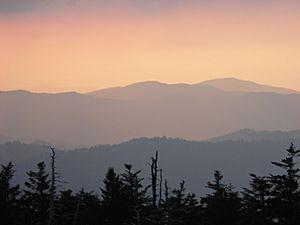On Top of Old Smoky facts for kids
"On Top of Old Smoky" (sometimes spelled "Smokey") is a classic folk song from the United States. It became very popular in 1951 when The Weavers, a famous folk group, recorded it. The song even made it onto the pop music charts! It's known as Roud Folk Song Index No. 414.
Contents
How the Song Became Popular
Long ago, a music expert named Cecil Sharp collected many folk songs from the Appalachian Mountains. This was before these songs became widely known and sold as commercial music. This is how modern country music started!
The first person to record "On Top of Old Smoky" for people to buy was George Reneau. He was known as "The Blind Musician of the Smoky Mountains." George played music on the streets in Knoxville, Tennessee, which is near the Appalachians. In 1925, he traveled to New York City to record this song and others for Vocalion Records. His version used a different tune than the one most people know today.
The Folk Music Revival
In the 1940s and 1950s, there was a big folk music revival in the United States. This meant old folk songs became popular again. Pete Seeger was a very important person during this time. He learned many songs, some from experts like Cecil Sharp. Pete's music was loved by many, and his recordings were sold everywhere.
Pete Seeger learned a version of "On Top of Old Smoky" from the Appalachian region. He changed some of the words and added new banjo music. He believed that some parts of the song were very old, possibly from the Elizabethan era in England. When the sheet music for the song was published, it gave Pete Seeger credit for the "new words and music arrangement."
The Weavers' Hit Version
The Weavers were a folk singing group that Pete Seeger helped start. On February 21, 1951, they recorded a very popular version of "On Top of Old Smoky" using Pete's arrangement. Decca Records released it, and it quickly became a huge hit! It reached number 2 on the Billboard chart and number 1 on the Cash Box chart. Over a million copies of their recording were sold!
Burl Ives, another famous folk singer, also had a hit with the song in 1951. His recording reached number 10 on the Billboard chart.
Because these recordings were so popular, the song became a folk song again! Most Americans know "On Top of Old Smoky" from when they were kids. Many people don't even realize it became so famous because of these recordings from the mid-1900s.
Other Modern Versions
After The Weavers made "On Top of Old Smoky" popular again, many other famous singers recorded it. It became a standard song in popular music.
- In 1951, the Swedish group Flickery Flies, with Brita Borg, recorded a Swedish version.
- Bing Crosby included the song in a medley on his album 101 Gang Songs in 1961.
- Harry Belafonte recorded a version for his 1962 album The Midnight Special.
- Alvin and the Chipmunks covered the song for their 1962 album The Chipmunk Songbook.
- In 1963, the tune was used for a German hit song called "Ich geh' noch zur Schule" (meaning "I Still Go to School"). It was about a teenage girl who wanted to finish school before becoming a singer.
- Little Eva, famous for "The Loco-Motion", recorded a fun version called "Old Smokey Locomotion" in 1963. The lyrics described people on Old Smokey doing "The Locomotion" dance!
- On the 1978 Bert & Ernie Sing-Along album from Sesame Street, Grover sang a funny version. He changed the lyrics to be about losing his clothes and lunch, but then finding them again.
- In 1978, the Swedish pop group ABBA (with lead vocals by Frida) released "On Top of Old Smokey" as part of a medley. It was on the B-side of their single "Summer Night City".
- Bruce Springsteen performed the song in Portland, Oregon, in 1980. He did this as a tribute after the 1980 eruption of Mount St. Helens.
- In a 1990 episode of the TV show Twin Peaks, a character named "Big Ed" Hurley sang the song to his wife.
- Fans of the English football team Notts County FC have sung a version of the song at games since 1990. Their version starts with "I had a wheelbarrow, the wheel fell off."
Use in Classical Music
In 1953, a composer named Ernő Dohnányi used the tune of "On Top of Old Smoky" in his last musical piece. It was called American Rhapsody, and it also used two other traditional American folk tunes.
Images for kids




